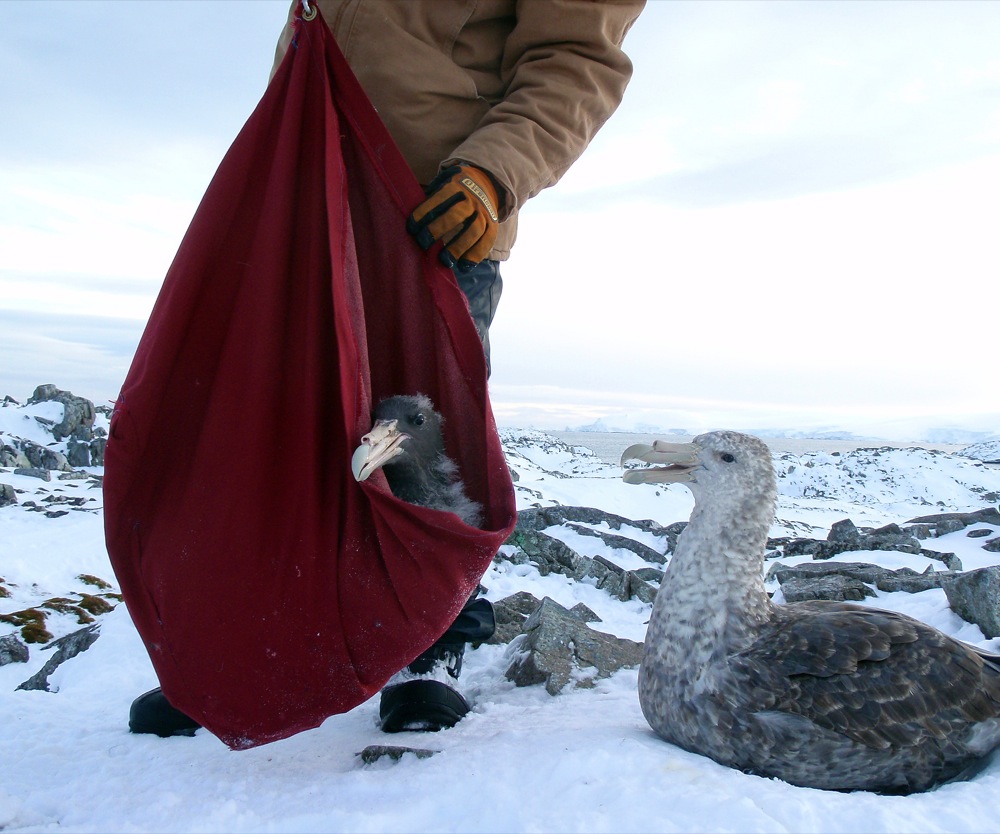A giant petrel watches Ryan Wallace weigh its baby as Wallace assists research scientists on an island off Palmer Station, Antarctica. JEFF OTTEN, NATIONAL SCIENCE FOUNDATION
Appalachia journal

Longtime employees of the company that supports the National Science Foundation describe the unique addiction to Antarctica that takes hold
Come work on the coldest, highest, and driest continent in the world. If that entices you, you are not the typical employee. Antarctica is essentially a landform covered by a very thick hunk of ice owned by no country. The population is but a fraction of even the Emperor penguins—that is, about 4,000 people from many nationalities live there during the warm months, or the austral summer, October through February. During the dark austral winter, which is the northern hemisphere’s summer, the population shrinks to about 1,000.
Competition will be fierce if you want to join the group who assist the U.S. Antarctic Program at the bottom of the world. Lawyers, physics majors, business managers, Peace Corps workers, and teachers compete to start out as snow shovelers and inventory movers. They hear about such work during chance conversations at a party, perhaps, or through friends who know they’re looking for adventure. They apply, they wait for their chance, and, when it comes, they put their belongings in storage.
When they’re down on “the Ice,” scrimping on everything an American calls normal, these workers find more verve in living than they ever had before. They don’t miss the American holiday season. They don’t mind wearing huge down coats just to go to the next building. They are the service employees of Raytheon Polar Services, a Denver-based company that for the past several years has provided the lion’s share of equipment, supplies, and assistance to the scientists who receive grants from the National Science Foundation to study birds, climate, weather, and more.
Each year, Raytheon hires about 1,000 new employees to work on the American service labor force of roughly 1,500 on the Ice. (The rest of the Antarctic research population comes from other countries.) They call it the Ice because a very thick sheet of ice covers 98 percent of the international territory. In some places, the Raytheon employee primer warns, the ice is 3 miles thick.
Employees go to one of three stations, two ships, or one of the several remote field camps. The largest station is McMurdo, located on the northeastern coast “under New Zealand,” as they say. About 800 miles to the south lies Amundsen-Scott South Pole Station, located at 90 degrees south latitude. The smallest station is Palmer, to the northwest, on Anvers Island, “under South America.” The austral summer, from October through February, is the busiest season by far. Only skeleton crews work the rest of the year. (About 150 at McMurdo and 45 each at the others in the off months.) Employees fly in on commercial and Air Force planes to McMurdo and “Pole,” as they call the South Pole station. To reach tiny Palmer Station, workers first fly to Punta Arenas, Chile, then take a ship for three to several days, hoping the seas will remain calm. Employees live dormitory-style and eat in dining halls. Fresh fruit and vegetables last for the first few weeks they’re there and, maybe, more arrive.
To read the rest of this article in the Winter/Spring 2010 issue of Appalachia journal, subscribe to the journal by visiting the Appalachian Mountain Club’s web page for Appalachia.
About This Article
The full version of this article appears in the Winter/Spring 2010 issue of Appalachia journal, which I also edit. About a year ago, I met a woman at a cafe in New Hampshire who spent half the year as a service employee in Antarctica. I soon learned that a community of hundreds of adventurous adults divide their jobs into two: first, the summer in North America, in the sun and usually warm temperatures, working for forestry service or the Appalachian Mountain Club or as an office temp; then, the austral summer in Antarctica, which is colder than our winter but with sunlight day and night. Eventually, I’ll post the entire article here, but not until a new issue is out. You can buy Appalachia at Barnes and Noble bookstores or online.
